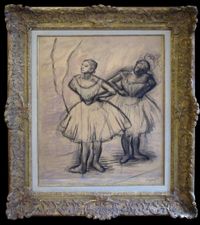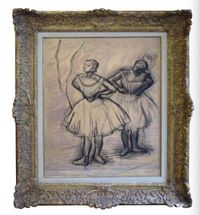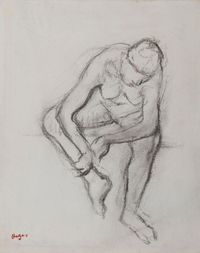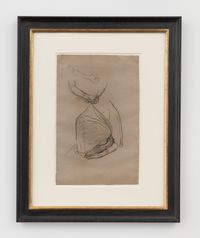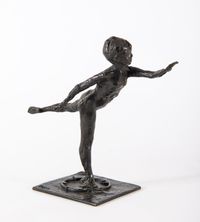Edgar Degas was a founding member of the outdoors Impressionist group and an artist later paradoxically famous for his elegant and sympathetic images of women indoors, such as ballet dancers doing warming up exercises, or washer women scrubbing laundry in tubs.
Read MoreDegas is greatly admired for his paintings, range of prints, bronze sculptures, and pastel drawings.
Born into a prosperous family, Degas' talent was spotted by his father early on. Degas was encouraged to copy works in museums like the Louvre and, at 18, to convert a room in the family home into a studio.
In 1855 he studied classical art techniques at the École de Beaux-Arts under Ingres, aspiring to be an academic portrait painter. See, for example, Male Nude (1856). Then he went to Italy for three years, staying with an aunt in Naples.
Returning to Paris he began to work on formal family portraits like The Bellelli Family (1860—1862), history paintings, and studies of horses. In the mid-1860s he became friends with Édouard Manet. With the 1870 Franco-Prussian war he became a rifleman but found he had eye problems.
After the war Degas went to New Orleans, staying with his brother and creating paintings using posed family members. Surprisingly one of these, A Cotton Office in New Orleans (1873), sold to an institution. That year he returned to Paris and joined an independent group of artists that became the Impressionists, getting to know James Tissot, Claude Monet, Camille Pissarro, Paul Cézanne, Pierre-Auguste Renoir, and Henri Fantin-Latour—artists that were more experimental in disposition.
Starting with outdoor paintings of punters at the race track, Degas moved to indoor images of dancers training in studios, women labouring at work like the washing of clothes, and people in theatres or shops, like milliners. Degas thought of himself as a realist, being more interested in psychological complexity than light on surfaces. Examples of work in this period include Orchestral Musicians (1872) and The Ballet Class (1871—1874).
Superb at sketching, Degas was compositionally influenced by Japanese prints and snapshot photography, with figures now extending beyond the frame, and abruptly truncated. Also with these vistas came unusual angles, so that perspective was accentuated and key items of furniture and salient figures seen at different distances from the viewer.
During his career Degas became an expert collector of contemporary French art and Japanese prints, and a passionate photographer. The latter encouraged him to reduce the role of saturated colour in his oil paintings. He became interested in the role of movement within public architectural interiors, and the psychological information conveyed by body posture. See for example, Singer with a Glove (1878), The Tub (1886), Ballet Scene (1879), and The Curtain (1880).
Despite being known for his quick acerbic wit, Degas disliked controversy and scandal, and eventually tried to bring non-Impressionists into the group to depoliticise its focus. The resulting tension helped bring about the group's demise in 1886. Overall, it had had eight exhibitions. While in his prime Degas was quick-witted and entertaining, as an older personality he could also be venomous and feared, losing all his painter friends eventually—particularly the Jewish and Protestant ones that he abused directly and cut himself off from—and so he died in 1917, blind and a recluse.
Edgar Degas' work is collected by major institutions across the world. These include Musée d'Orsay, Paris; Musée Gustave Moreau, Paris; Tate Modern, London; Victoria and Albert Museum, London; and Metropolitan Museum of Art, New York.
Recent solo exhibitions include Degas at the Opéra, National Gallery of Art, Washington, D.C. (2019); Drawn in Colour: Degas from the Burrell Collection, The National Gallery, London (2017); Edgar Degas: A Strange New Beauty, Museum of Modern Art, New York (2016); Degas: A New Vision, National Gallery of Victoria, Melbourne (2016).
John Hurrell | Ocula | 2021
